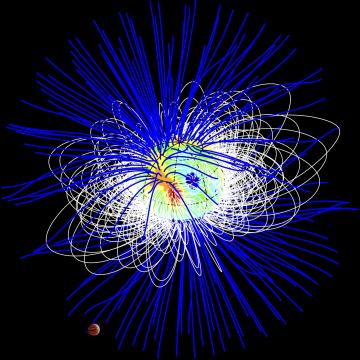2016 June: Newborn Giant Planet Grazes its Sun
Unveiling the birth of stars and their planets with SPIRou
For the last 20 years the giant planets known as hot Jupiters have presented astronomers with a puzzle. How did they settle into orbits 100 times closer to their host stars than our own Jupiter is to the Sun ? An international team led by IRAP / OMP astronomers has announced this week in the journal Nature the discovery of a newborn hot Jupiter, orbiting an infant sun – only 2 million years old, the stellar equivalent of a week-old human baby. The discovery that hot Jupiters can already be present at such an early stage of star-planet formation represents a major step forward in our understanding of how planetary systems form and evolve.

For this discovery, the team monitored a 2 million-year-old infant star called V830 Tau, located in the Taurus stellar nursery, some 430 light-years away. Over the 1.5 months of the campaign, a regular 4.9-day “wobble” in the velocity of the host star revealed a giant planet almost as massive as Jupiter, orbiting its host star at a distance of only one-twentieth that of the Sun to the Earth distance. This discovery demonstrates for the first time that such bodies can be generated at very early stages of planetary formation, and likely play a central role in shaping the overall architecture of planetary systems.
For this discovery, the team used the twin spectropolarimeters ESPaDOnS and Narval, built at IRAP / OMP in Toulouse, France. ESPaDOnS is mounted at the 3.6-m Canada-France-Hawaii Telescope (CFHT) on Maunakea, a dormant volcano on the Big Island of Hawaii, whereas Narval is coupled to the 2-m Télescope Bernard Lyot (TBL) atop Pic du Midi in the French Pyrénées. SPIRou and SPIP, the twin new-generation instruments built for CFHT and TBL by IRAP / OMP and scheduled for first light in 2017 and 2019 respectively, will offer vastly superior performances for such programmes thanks to their operation at near infrared wavelengths at which young stars are brightest, and will soon allow us to explore the formation of new worlds with unprecedented sensitivity. Learn more about this story at http://www.ast.obs-mip.fr/article.php3?id_article=1014

More information on : tomographic techniques inspired from medical imaging


